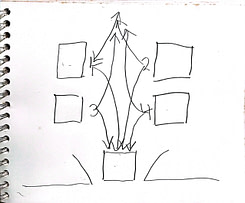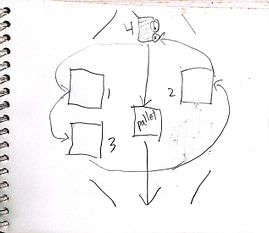Short Disclaimer:
For transparency, some content is drafted with the aid of ChatGPT, an AI language model, to assist in research, organization, and writing. Final accountability for all published material rests solely with me.
Click on the Tabs!
A Dialogue between Fred and his Mentor, Socrates, on How to Visualize Success
Socrates: Good day, Fred. You look a bit uneasy. What's on your mind about using flowcharts to make things smoother in your business?
Fred: Hello, Socrates. Honestly, I'm scared of making a mistake that leads us down the wrong path. It feels like a lot of pressure.
Socrates: Mistakes can be our teachers, right? Let's say you do mess up the flowchart; what's the worst that can happen?
Fred: Well, it could highlight something we’ve missed. But I can't shake the fear of leading my team astray.
Socrates: Ever think that maybe getting a bit lost is part of the journey? How does your team fit into this process?
Fred: They bring their views and skills. If we all work together on this, perhaps the fear of making a mistake isn't so scary.
Socrates: Exactly! So once everyone’s pitched in, and you've got this flowchart, what's the next move?
Fred: First, we’ll see how things actually work right now. Then we'll tackle anything that's gumming up the works or making us repeat ourselves.
Socrates: Makes sense. So you figure out what's up, and then clean house a little. Do you also intend to dig into why these issues exist in the first place?
Fred: That’s for later. First things first, let's fix what’s right in front of us. Then we can play detective.
Socrates: Nice, step by step. And how does your team react to these changes?
Fred: Everyone's a part of making the chart, so they're also a part of the fixes. It's less like I'm telling them what to change and more like we're figuring it out together.
Socrates: Can you give me an example of a flow chart that was both easy to do, and made it easier for all of you to figure out together how to make it better?
Fred: Sure! Here is one from our packaging room.
By the way, those are the real flowcharts we made. Nothing fancy but oh so effective!
Socrates: Sounds like a team effort, which is smart. What if some new problems pop up when you make these changes?
Fred: We'll test them out on a small-scale first, like a trial run. If something goes haywire, we catch it before it messes everything up.
Socrates: So you're basically using the flowchart as a roadmap but also as a testing ground?
Fred: Yeah, it’s like we're finding the bumps and potholes in our road and fixing them, but we're also open to changing our route if a better road comes along.
Socrates: You’ve come a long way from being worried, Fred. How do you feel about this now? Can you visualize success yet?
Fred: Much better, Socrates. It feels less like climbing a mountain and more like, well, smoothing out a dirt road.
Socrates: Great to hear! So, are you ready to embrace this process, warts and all?
Fred: I am. There’s still a bit of fear, but now it's just part of the adventure. Thanks for helping me see that.
Socrates: So, Fred, let me get this straight: You first visualize the current situation, then you remove what's unnecessary, and only then you dig into the 'why.' You visualize, you remove, you dig. It's a staged approach to breaking down the complexities of your process while aiming to visualize success. Is that correct?
Fred: Exactly, Socrates. You've captured it perfectly. It's all about manageable steps that lead us to a smoother, more effective operation. Now, I am beginning to visualize success.
Says the Devil's Advocate:
While Fred's approach to using flowcharts to visualize success is collaborative and incremental, there are areas for caution. First, the method assumes equal participation from all team members, which may not be realistic. Second, testing changes on a small scale is a good safety measure, but may not adequately capture the complexities or potential problems that arise when changes are fully implemented. Lastly, the multi-stage approach—visualize, remove, dig—might extend the timeline, risking a loss of team interest or momentum.
My response: All good points. To the first, I would say it evolves and becomes better over time. That is why it is called Continual Improvement. To the second and third, the same. There is no such thing as an Improvement event: It needs to be continual, it needs to be prioritized, and it must be adaptive.
Get Your Copy of Easy Fast Flowcharting for Accelerated Improvement NOW!
Sometimes the simplest solution is the best! "As simple as is necessary and no more"


